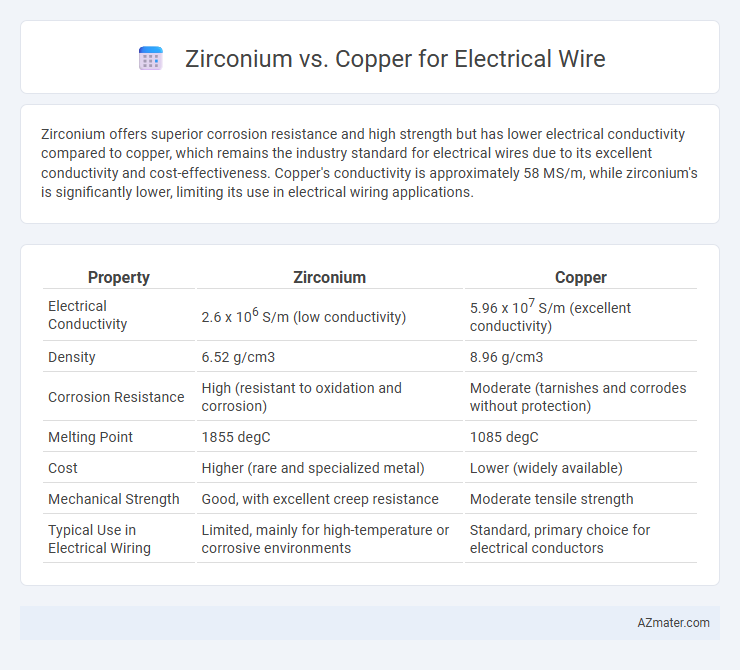Zirconium offers superior corrosion resistance and high strength but has lower electrical conductivity compared to copper, which remains the industry standard for electrical wires due to its excellent conductivity and cost-effectiveness. Copper's conductivity is approximately 58 MS/m, while zirconium's is significantly lower, limiting its use in electrical wiring applications.
Table of Comparison
| Property | Zirconium | Copper |
|---|---|---|
| Electrical Conductivity | 2.6 x 106 S/m (low conductivity) | 5.96 x 107 S/m (excellent conductivity) |
| Density | 6.52 g/cm3 | 8.96 g/cm3 |
| Corrosion Resistance | High (resistant to oxidation and corrosion) | Moderate (tarnishes and corrodes without protection) |
| Melting Point | 1855 degC | 1085 degC |
| Cost | Higher (rare and specialized metal) | Lower (widely available) |
| Mechanical Strength | Good, with excellent creep resistance | Moderate tensile strength |
| Typical Use in Electrical Wiring | Limited, mainly for high-temperature or corrosive environments | Standard, primary choice for electrical conductors |
Introduction to Zirconium and Copper in Electrical Wiring
Zirconium and copper are distinct metals used in electrical wiring, each with unique properties influencing performance and application. Copper, renowned for its excellent electrical conductivity of 5.96 x 10^7 S/m and high ductility, is the industry standard for wiring in residential, commercial, and industrial systems. Zirconium, less common in wiring, offers superior corrosion resistance and high-temperature stability but has lower electrical conductivity, making it suitable for specialized applications where durability under extreme conditions is critical.
Material Properties Comparison: Zirconium vs Copper
Zirconium exhibits higher corrosion resistance and superior strength at elevated temperatures compared to copper, making it suitable for specialized electrical wiring in harsh environments. Copper offers excellent electrical conductivity of about 5.96x10^7 S/m, far exceeding zirconium's conductivity, which is significantly lower, typically limiting its use in high-current electrical applications. While copper is more ductile and cost-effective for standard wiring, zirconium's unique thermal stability and non-magnetic properties provide advantages in niche, high-performance electrical systems.
Electrical Conductivity: Which Performs Better?
Copper exhibits higher electrical conductivity than zirconium, making it the preferred choice for electrical wiring in most applications. With a conductivity of approximately 59.6 million siemens per meter (MS/m), copper significantly outperforms zirconium, which has a much lower conductivity near 2.0 MS/m. This superior conductivity of copper allows for more efficient current flow and reduced energy losses in electrical systems.
Thermal Stability: Suitability for High-Temperature Environments
Zirconium exhibits superior thermal stability compared to copper, maintaining its mechanical and electrical properties at temperatures exceeding 1000degC, making it highly suitable for high-temperature electrical wire applications. Copper, while an excellent conductor at standard temperatures, begins to degrade and lose conductivity above 200degC, limiting its effectiveness in elevated thermal environments. Therefore, zirconium is preferred in aerospace, nuclear, and industrial settings where prolonged exposure to extreme heat demands reliable thermal performance.
Corrosion Resistance: Durability in Different Conditions
Zirconium exhibits superior corrosion resistance compared to copper, particularly in aggressive environments such as seawater and acidic atmospheres, making it ideal for applications requiring long-term durability. Its ability to form a stable oxide layer prevents degradation, unlike copper, which can corrode over time under similar conditions. This enhanced corrosion resistance translates to decreased maintenance and longer lifespan for electrical wiring in harsh or industrial settings.
Mechanical Strength and Flexibility of Both Metals
Zirconium exhibits higher mechanical strength than copper, making it more resistant to deformation under stress and suitable for applications requiring durable wiring. Copper, however, offers superior flexibility and excellent ductility, allowing it to bend easily without breaking, which is crucial for wiring installations with complex routing. While zirconium's rigidity enhances structural integrity, copper's combination of flexibility and strength supports high-performance electrical conductivity in dynamic environments.
Cost Analysis: Zirconium vs Copper Wire
Zirconium wire typically incurs higher costs than copper due to its limited availability and complex extraction process, impacting overall project budgets. Copper wire remains cost-effective with abundant supply and well-established manufacturing, making it a preferred choice for standard electrical wiring. However, zirconium offers superior corrosion resistance and strength, which may justify the investment in specialized applications despite the higher initial expense.
Applications: Where Each Metal is Used in Wiring
Zirconium is rarely used in typical electrical wiring but finds niche applications in high-temperature and corrosive environments, such as nuclear reactors and aerospace systems, due to its excellent resistance to oxidation and thermal stability. Copper dominates electrical wiring in residential, commercial, and industrial settings because of its superior electrical conductivity, flexibility, and cost-effectiveness, making it ideal for power transmission, electrical circuits, and electronic devices. While copper remains the standard for general electrical applications, zirconium's specialized properties make it valuable for wiring exposed to extreme conditions requiring enhanced durability and corrosion resistance.
Safety Considerations in Electrical Installations
Zirconium offers superior corrosion resistance and high thermal stability compared to copper, enhancing safety in electrical installations by reducing the risk of overheating and electrical fires. Copper, while highly conductive, is more susceptible to oxidation and degradation over time, potentially leading to unsafe connections. When prioritizing safety, zirconium's durability under extreme conditions makes it a preferable choice in critical or specialized wiring applications.
Future Trends and Innovations in Electrical Wire Materials
Zirconium is emerging as a promising electrical wire material due to its superior corrosion resistance and high thermal stability compared to copper, which has long dominated the market because of its excellent electrical conductivity and cost efficiency. Innovations in nanotechnology and alloy development are enhancing zirconium's conductivity and mechanical strength, positioning it as a viable alternative in high-performance and extreme environment applications. Future trends point to hybrid wire composites combining copper and zirconium to optimize conductivity, durability, and weight, driving advances in electric vehicle wiring and renewable energy infrastructure.

Infographic: Zirconium vs Copper for Electrical wire
 azmater.com
azmater.com